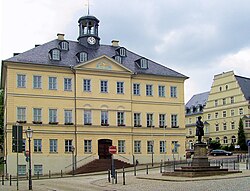Hainichen is a market town in Saxony, Germany. It is located on the river Kleine Striegis and about 15 miles (24 kilometres) north-east of Chemnitz. Hainichen has been shaped by its industrial past.
Hainichen | |
|---|---|
 Hainichen town hall | |
Location of Hainichen within Mittelsachsen district  | |
| Coordinates: 50°58′11″N 13°7′31″E / 50.96972°N 13.12528°E | |
| Country | Germany |
| State | Saxony |
| District | Mittelsachsen |
| Government | |
| • Mayor (2018–25) | Dieter Greysinger[1] (SPD) |
| Area | |
| • Total | 51.57 km2 (19.91 sq mi) |
| Elevation | 304 m (997 ft) |
| Population (2022-12-31)[2] | |
| • Total | 8,448 |
| • Density | 160/km2 (420/sq mi) |
| Time zone | UTC+01:00 (CET) |
| • Summer (DST) | UTC+02:00 (CEST) |
| Postal codes | 09661 |
| Dialling codes | 037207 |
| Vehicle registration | FG, BED, DL, FLÖ, HC, MW, RL |
| Website | www.hainichen.de |
History
editFrom the foundation until industrial revolution
editA first settlement had been mentioned in 1276 as villa forensis Heynichen.
Hainichen used to be a place of considerable industry. Its primary manufacture was once that of flannels, baize, and similar fabrics; at the time it may have been called the centre of this industry in Germany.[3]
On April 23, 1800, a F5/TORRO10 tornado devastated Arnsdorf, Dittersdorf and Etzdorf, near Hainichen. Despite its strength, there were no deaths.[4]
The Gellert institution for the poor was established in 1815.[3]
In 1933, a production plant for small delivery vans and minibuses called Framo moved from nearby Frankenberg to Hainichen. Since then, the automotive industry has been the most important employer.
Nazi era
editAn early concentration camp, Hainichen concentration camp, was established in April 1933 and dissolute in June 1933. During World War II, a subcamp of Flossenbürg concentration camp was located here, housing female prisoners working for the Framo enterprise.[5]
GDR
editThe former plant of the Framo company was nationalized. The 1960s saw a reingeneering of delivery vans and minibuses under the Barkas B1000 brand. Hainichen became a major producer of parts for these cars.
After reunification
editProduction of the B1000 delivery vans and minibuses ceased in 1991.
Population statistics
editSource:[6]
Typical for a market town in the east of Germany, Hainichen faces the demographic problem of a steadily declining population.
| Year | Population |
|---|---|
| 1834 | 4,623 |
| 1933 | 8,047 |
| 1960 | 11,188 |
| 1998 | 10,405 |
| 1999 | 10,266 |
| Year | Population |
|---|---|
| 2000 | 10,061 |
| 2001 | 9,888 |
| 2002 | 9,744 |
| 2003 | 9,628 |
| 2004 | 9,554 |
| Year | Population |
|---|---|
| 2005 | 9,502 |
| 2008 | 9,131 |
| 2010 | 8,876 |
| 2012 | 8,714 |
Leisure and tourism
editSites and buildings of interest
editHainichen is home of a camera obscura.
Other important sights are the Gellert museum (literature museum), Tuchmacherhaus (clothier museum) and a communal park. Hainichen is surrounded by the beautiful valleys of the river Striegis.
Sports
editHainichen has a communal sports centre with a small indoor pool, a communal outdoor swimming pool and a bowling centre. Also, there is a cycling track nearby.
Industry
editHainichen is characterised by small and medium-sized businesses. The largest employer is the car parts maker Metalsa Automotive Hainichen GmbH (formerly ISE Industries Hainichen GmbH) (429 employees in 2005).
Districts
editAreas of the city include
- Bockendorf,
- Cunnersdorf,
- Eulendorf,
- Gersdorf,
- Falkenau,
- Riechberg,
- Siegfried,
- Schlegel and
- Berthelsdorf.
International relations
editHainichen is twinned with:
Famous citizens
edit- Hainichen is the birthplace of Christian Fürchtegott Gellert (1715–1769), to whose memory a bronze statue was erected in the marketplace in 1865. He was an important poet of the Enlightenment.
- Friedrich Gottlob Keller (1816–1895), the inventor of the groundwood pulp technique, was born in Hainichen.
More sons and daughters of the town
edit- Rainer Simon (born 1941), film director and screenwriter
- Konrad Zdarsa (born 1944), Bishop of the Diocese of Augsburg
References
edit- ^ Bürgermeisterwahlen 2018, Freistaat Sachsen, accessed 10 July 2021.
- ^ "Einwohnerzahlen nach Gemeinden als Excel-Arbeitsmappe" (XLS) (in German). Statistisches Landesamt des Freistaates Sachsen. 2024.
- ^ a b Chisholm, Hugh, ed. (1911). . Encyclopædia Britannica. Vol. 12 (11th ed.). Cambridge University Press. p. 822.
- ^ "Tornado in Hainichen am 23.04.1800". tornadoliste.de. Retrieved 2022-07-28.
- ^ Christine O'Keefe. Concentration Camps
- ^ Source from 1998 onwards: Statistical office of Saxony Numbers from 1960 onwards per 31 December.
- ^ "List of Twin Towns in the Ruhr District" (PDF). Twins2010.com. Archived from the original (PDF) on 2021-02-25. Retrieved 2009-10-28.


